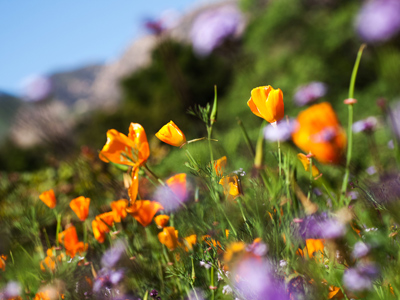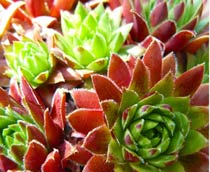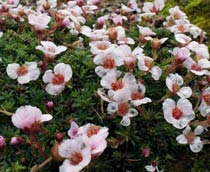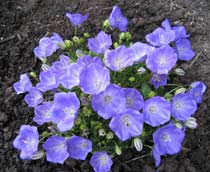
Alpines can add interest to a garden.
Alpines - Alpines 2
If you love plants but are not too keen on all the digging, hoeing and weeding that often goes with them then maybe rock plants are for you - all the joy of gardening but in miniature!
Rockeries come in all shapes and sizes from the huge rambling banks of plants you see in botanical gardens to the tiniest portable containers. There are rock plants to suit all purposes and all levels of enthusiasm. This quiz will test your knowledge of some of the more popular subjects and tell you a little about the more unusual ones.
1 .
Which plant nutrient makes the flowering stems of plants like the Iceland Poppy grow too long and leggy?
Nitrogen
Magnesium
Phosphorous
Potassium
- Latin Name: Papavar nudicaule.
- It is believed that Poppies have been grown for decorative purposes for over 7,000 years.
- Requires a very free draining soil - especially important during the winter because being waterlogged for even a short time will kill it.
- The plants are perennial but seldom do well after about 2 years.
- Very easy to grow from seed - it is worth sowing a few each autumn and transplanting to 'bare patches' on the rockery in the spring.
By keeping plants such as this 'deprived' of nitrogen you can ensure that they stay compact in the rock garden
2 .
To which of the following plants is Lewisia closely related?
Papaver
Phlox
Portulaca
Pratia
- Latin name: Lewisia longipetala.
- This is a choice variety of alpine plant, much prized by Lewisia enthusiasts.
- In the wild the plant is never far from snow and it suffers badly if it is deprived of water.
- It is usually found on icy, north facing slopes at high altitudes where little else will grow.
- If you have built a typical rockery for plants that require free-draining soil then maybe this one should be given a miss!
Both Lewisia and Portulaca belong to the purslane family
3 .
This is Sedum Oreganum and the flowers are similar to those on Sedum Acre. Why is Sedum Acre NOT recommended for use in gardens?
It is expensive
It is invasive
It is poisonous
It is protected
- There are very many Sedum species that are suitable for use in rockeries.
- With so much choice it is wise to take a little time to make sure that you get only the better varieties.
- Sedums are renowned for propagating easily from cuttings.
- Taking a piece from a friend's plant is often quite acceptable but taking a piece from public gardens is likely to get you thrown out!
Tiny pieces broken off Sedum Acre and spread by animals, birds or the wind will take root and grow almost anywhere. You have been warned!
4 .
What is the common name for Silene Acaulis
Alpine totara
Creeping dogwood
Moss campion
Silver bush
- A common wildflower in the high mountains of Europe and North America.
- Flowers are usually pink but a white flowered variety is available.
- Produces 'cushions' that are so dense that they capture and retain the heat of the sun in the plant's own micro-climate!
- Easily grown from seed and it is happy to grow in most soil types.
5 .
Dianthus alpinus along with many other rockery plants are said to be suitable for xeriscaping. Where is this most appropriate?
Cold climates
Hot climates
Dry climates
Wet climates
- The plant is usually known as the alpine pink.
- Brings a splash of colour to a rock garden area in mid summer - after most alpines are past their best.
- A favourite of many keen gardeners.
- There is an ongoing debate about whether it grows best on acid or alkali soils. It is probable that soil pH is sometimes blamed for bad results when the cause of the problem is actually poor drainage.
Xeriscaping is a form of gardening using plants that never need supplementary irrigation
6 .
What is the common name of this plant?
Houseleek
Kill-me-not
Seashell plant
Shedroof plant
- Latin name: Sempervivum.
- In some parts of the country it has earned itself the self-explanatory name of 'Liveforever'!
- Succulent plants that never die through lack of water.
- Sempervivums come in many different forms including one known as Hen and chicks and another known as the Cobweb houseleek.
- Sometimes they throw a pink or white flower but this depletes their food reserves and they then look unwell for a year or two afterwards.
7 .
Where in the UK is the national collection of Saxifrages held?
Cambridge
Kew
Oxford
Wisley
- Latin name: Saxifraga x irvingii 'Jenkinsiae'.
- There are over 400 different species of Saxifrage, many of which are suitable for growing in rock gardens.
- Some species can be grown from seed and are fairly easy to germinate.
- Choice varieties are usually propagated from cuttings.
- Prefers a well drained soil and the colder the region the better it grows.
The national collection is kept at the Cambridge University Botanic Gardens
8 .
Which of the names below is not used for Armerica Maritima
Sea anemone
Sea pink
Sea thrift
Thrift
- The plant is able to withstand very saline conditions and is found growing wild along the coasts of the UK.
- It forms low hummocks which throw out many flowers.
- The most usual colour for the flowers is pink but white and purple varieties can also be purchased.
- For many years the old threepence coin in the UK carried a design of the plant.
- A favourite plant for alpine areas owing to its low maintenance requirements.
9 .
The shape of the flower gives a clue to the common name of this plant. What is it?
Bellflower
Domeflower
Cupflower
Saucerflower
- Latin name: Campanula Carpatica.
- Most widely grown varieties are 'Blue Clips' and 'White Clips'.
- Fairly easy to raise from seed. You can buy 1,000 seeds for little more than £1.00!
- Thrives on any rockery where the soil is not particularly heavy.
- It is advantageous (but not essential) to dead head the flowers in order to prolong the flowering season.
Most Campanula species are known as Bellflowers. This particular variety is often called the Carpathian bellflower
10 .
This species of Phlox is one of the best for rockeries. What is its name?
Bertii
Charlesii
Douglasii
Erecii
- Often known as the Moss Phlox because of its habit of forming low, dense cushions of growth.
- This particular variety is called MacDaniels's Cushion.
- Named varieties are usually propagated by either cuttings or division.
- Prefers light, well drained soil and is an ideal choice for providing colour on the rockery in late spring and early summer.
**Unlimited Quizzes Await You! 🚀**
Hey there, quiz champ! 🌟 You've already tackled today's free questions.
Ready for more?
Ready for more?
🔓 Unlock UNLIMITED Quizzes and challenge yourself every day. But that's
not all...
not all...
🔥 As a Subscriber you can join our thrilling "Daily Streak" against other
quizzers. Try to win a coveted spot on our Hall of Fame Page.
quizzers. Try to win a coveted spot on our Hall of Fame Page.
Don't miss out! Join us now and keep the fun rolling. 🎉
**Unlimited Quizzes Await You! 🚀**
Hey there, quiz champ! 🌟 You've already tackled today's free questions. Ready for more?
🔓 Unlock UNLIMITED Quizzes and challenge yourself every day. But that's not all...
🔥 As a Subscriber you can join our thrilling "Daily Streak" against other quizzers. Try to win a coveted spot on our Hall of Fame Page.
Don't miss out! Join us now and keep the fun rolling. 🎉

















